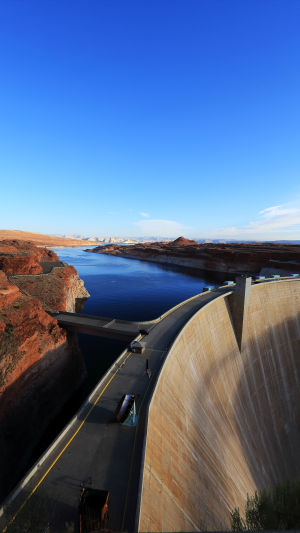The Glen Gap Dam is located in Arizona, U.S.A., on the Colorado River at Glen Gap.
The reservoir is called Lake Powell, upstream of Hoover Dam, 21km from the Utah border.
The project has comprehensive benefits such as navigation, power generation, irrigation, flood control and fish farming.
The dam is a concrete arch dam with a maximum height of 216.4m and a total reservoir capacity of 33.3 billion m3, with a total installed capacity of 1.042 million kW and a planned expansion to 1.32 million kW.
The width of the valley floor at the Glen Canyon dam site is about 210m, and the slopes of the two banks are nearly vertical, with the left bank at about 70° to 80° and the right bank at an elevation of 1000m or less.
While the slopes of the valley above are upright, and the relative height difference between the two banks is about 200m.
In 1963, the Americans built the 216-meter-high Glen Canyon Dam in the Grand Canyon.
However, what the dam builders did not expect was that the ecology of the Grand Canyon area was also severely damaged.
Today, scientists are planning another bold attempt to restore the ecology of the Grand Canyon: opening the spillway of Glen Canyon Dam to allow the Colorado River to flow freely.
Before the dam was built, the Colorado River took 57 million tons of sediment each year, and the water was a muddy red color.
Every spring, when the snow and ice on the Rocky Mountains melt, the temperature of the river can be as low as nearly 0°C.
In summer, the water temperature can be as high as 32°C again.
And when the spring flood breaks out, its flow can reach more than twice the amount of that man-made flood in 1996, and wash away the sediment deposited in the riverbed.
So that the river banks on both sides of the Grand Canyon can be renewed.
After the dam was built, more than 90% of the sediment was deposited in Lake Powell behind Glen Canyon Dam, and the Colorado River became clear and flowed slowly all year round, with the water temperature remaining at 9 degrees Celsius.
Lake Powell is the second largest reservoir in the United States, formed by the Glen Canyon Dam water storage.
It is reported that the water level of Lake Powell has fallen to the lowest level since 1969, and it continues to fall.
At the same time, the negative effects of the dam have gradually emerged.
For example, three of the eight species of native fish in the Colorado River have disappeared, while another rare species named blowback salmon (humpback chub) has seen a dramatic reduction in numbers from 8,000 to about 2,000 in the past 20 years.
It should be said that at the time of the construction of Glen Canyon Dam, the bitter fruit has been brewed.
According to the New York Times, when Glen Canyon Dam was built, no one realized that the ecology of the Grand Canyon area would be completely changed as a result.
And in 1971, a civil engineer finally came forward to warn that the sandbars and beaches of the Colorado River would eventually disappear.
But at the time, such voices seemed unusually weak, and no one listened at all.
In recent years, similar voices draining Lake Powell and abandoning Glen Canyon Dam have continued to appear in the United States.
So far, it is known that the United States, which has been a world leader in building dams over the past 100 years, has removed 465 dams, in order to restore the original river face.





